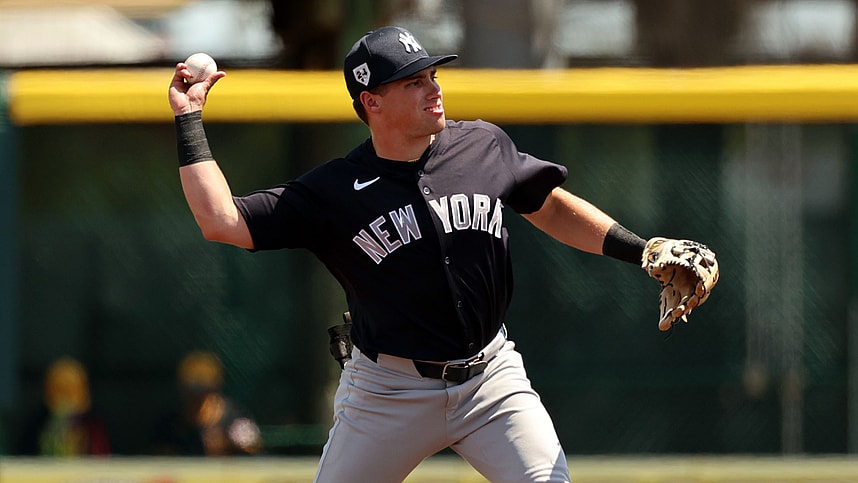
Caleb Durbin is one of the few prospects in the Yankees’ organization who stayed both effective and healthy enough to progress even further from their 2023 seasons. It’s been a tough year on the farm given how many injuries they had combined with the lack of success from prospects to correct a massive issue in their game. Durbin has posted an OPS nearing .900 while walking more than he’s struck out, but that doesn’t ensure that the utility man will make it at the Major League level.
There’s not a realistic world where Caleb Durbin develops to generate much more than below-average game power, but can he be one of the few who become productive big leaguers despite that flaw?
How Caleb Durbin Has Become a Unique Kind of Hitter

When you think of hitters like Caleb Durbin, you think of your stereotypical slap hitter who tries to force contact to have success. While I don’t doubt that the 24-year-old infielder relies on his contact tool to at least give his wheels a chance to make some mayhem. He’s the kind of scrappy player who can beat out a slow roller and spark a rally, but that kind of playstyle works a lot better in the terrible defensive environment that is Minor League Baseball.
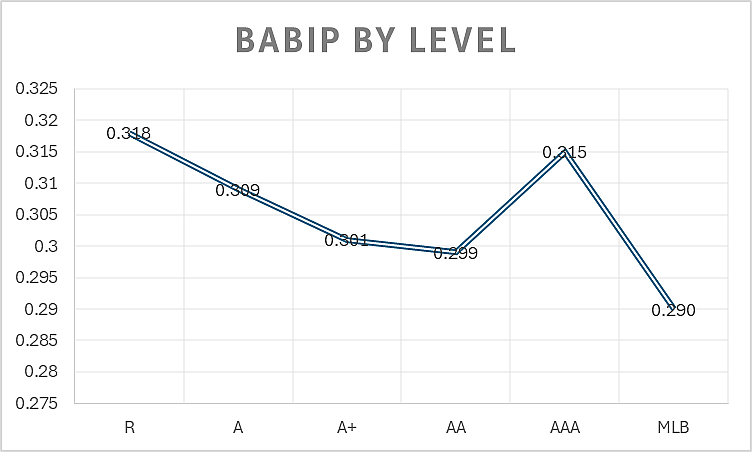
The only level where we see BABIP increase after a jump is Triple-A, and that’s because the baseballs used at that level best resemble the ones used in the big leagues. Adjusting to that ball can take time for pitchers, which is why their vertical ride (IVB) can be diminished in the first few outings at that level, thus meaning hitters have an advantage when they face a pitcher coming up for the first time that they normally would not have.
We also see that the Automated Ball-Strike Zone can create some weird situations for pitchers (such as ones with good breaking balls), and those are typically the toughest pitches for prospects to pick up. Any hitter running an extremely high BABIP should expect to see some heavy regression unless they’re driving the baseball, and Durbin would be a prime example of the kind of hitter who would struggle to maintain a high BABIP at the next level, but he’s not that BABIP-reliant.
READ MORE: The Yankees face one catastrophic issue with their offense
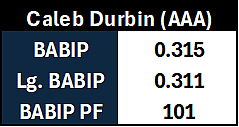
Caleb Durbin is running roughly average BABIP rates at a ballpark in Scranton where BABIP is slightly inflated, but the overall Park Factor there (95) would indicate that wRC+ is selling short his offensive contributions. You might be confused as to why a metric that’s intended to account for these discrepancies would struggle to capture park-adjusted offense, but FanGraphs doesn’t include Park Factor in its adjustment calculations. That means that not only is he not getting fat in unsustainable batted-ball luck, but he’s also being undervalued offensively.
When he got to High-A with the Yankees, Caleb Durbin relied on a .064 ISO and .377 BABIP to post a .861 OPS and quickly get promoted to Double-A. That kind of prospect isn’t going to be sought-after, a 20 in both game and raw power to any prospect evaluator with a good understanding of his profile. Things improved at Double-A, sporting a .149 ISO and .290 BABIP with his 122 wRC+ in Somerset, meaning he was less reliant on weak hits and could generate some game power; probably a 20 raw power and 30+ game power player.
Power has finally started to click for Durbin, who has hit four home runs over his last 18 games after hitting just four all of last season. His .178 ISO is better than the average mark for the International League (.166), which gives him around 50-grade game power if we were to grade this specific season. That’s not even accounting for the lack of power in that ballpark relative to others that we touched on earlier, but thanks to his spray angles, Caleb Durbin has found a way to generate multiple bases per hit.
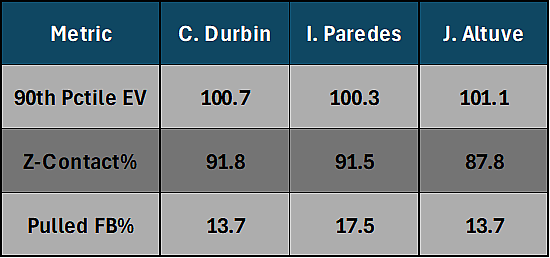
Caleb Durbin profiles very similarly to two titans in the pulled flyball game, having similar pulled flyball rates to Jose Altuve with a better hit tool, and while Paredes pulls the ball more often than both of them, he offers the second-best contact rate and the worst raw power of the trio. I don’t think Durbin will become the hitter these two have, it’s an irresponsible projection, but the upside of this archetype can certainly be rewarding.
We view these kinds of hitters as flukey in many cases because we only pay attention to Expected Stats that do not take into account direction with batted ball data. Hitters can train themselves to try and get out in front more often, and I believe that’s something that Caleb Durbin did over the offseason. The increase in game power alongside a sub-10% strikeout rate is always encouraging, and he’s starting to become better at making quality swing decisions.
Once a slap hitter, Caleb Durbin has started to chase power in the only way hitters with his power output can realistically do so.
When Could the Yankees Promote Him to The Show?
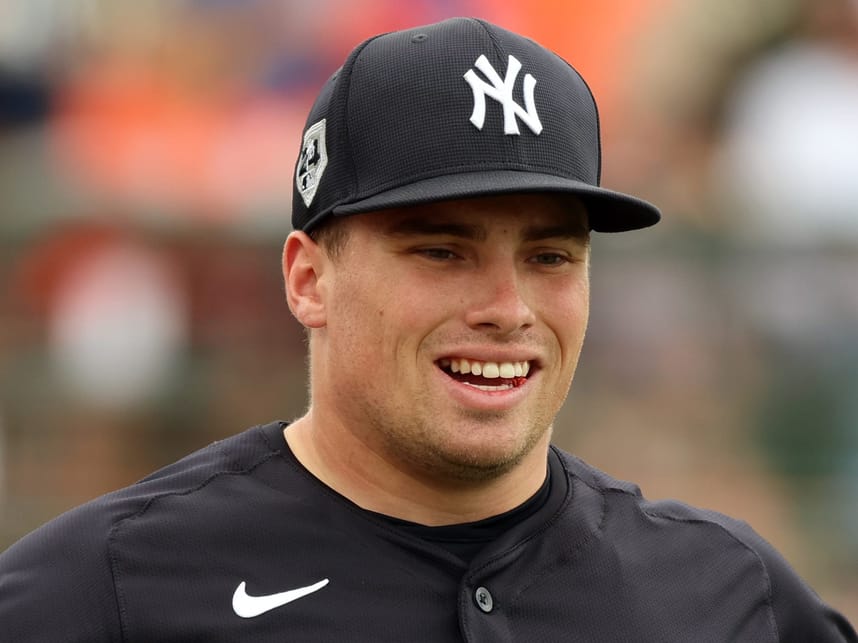
I’d all but rule out a potential late-season promotion unless a substantial infield injury goes down, but in that case, they could just use Jon Berti who has experience at second, third, and shortstop. The versatile infielder can also help a team in their outfield, but Jasson Dominguez would be the logical selection if they needed outfield help, and Greg Allen is the veteran in Triple-A who’d likely get the brief 40-man appearance given outfield depth beyond their top prospect was required.
2025 is a much more realistic window for Caleb Durbin, who wouldn’t have to battle with someone like Gleyber Torres for a job in all likelihood. He’s the best-performing infield prospect they have, and his versatility would allow him to rover around the infield if necessary. The Yankees raved about him in Triple-A, and if the power continues to improve the way it has this season then perhaps he’s more than a solid bat.
READ MORE: The Yankees might have their All-Star version of lefty starter back
Durbin has a projected 94 wRC+ for the remainder of the 2024 season, and if you got a 95-100 wRC+ from him in year one next season he might be a solid starting infielder. The Yankees love his defensive abilities on the dirt, and it’s possible that he could accumulate serious value defensively and on the basepaths while providing a steady bat out of the nine-hole, very similar to someone like Brett Gardner.
It took some juiced baseballs as well, but his late-career explosion in power that came in 2019 is a great example of a hitter with below-average raw power finding a way to leverage all of their raw power into game power. Maybe this is just one giant hot streak; the fun about prospects is that we will never truly know until they play a meaningful sum of Major League games.
There’s a lot that Caleb Durbin had to excel at in order to even be in consideration for Major League reps, but he might just be able to nail down the one tool that held him back for years.
More about: New York Yankees